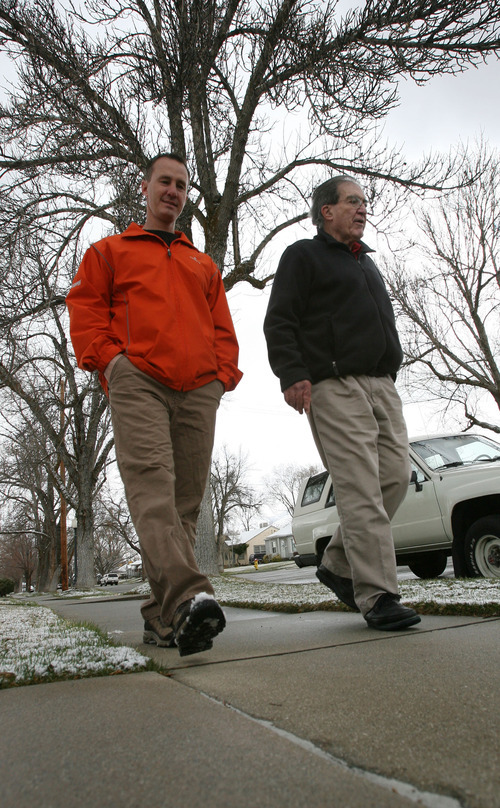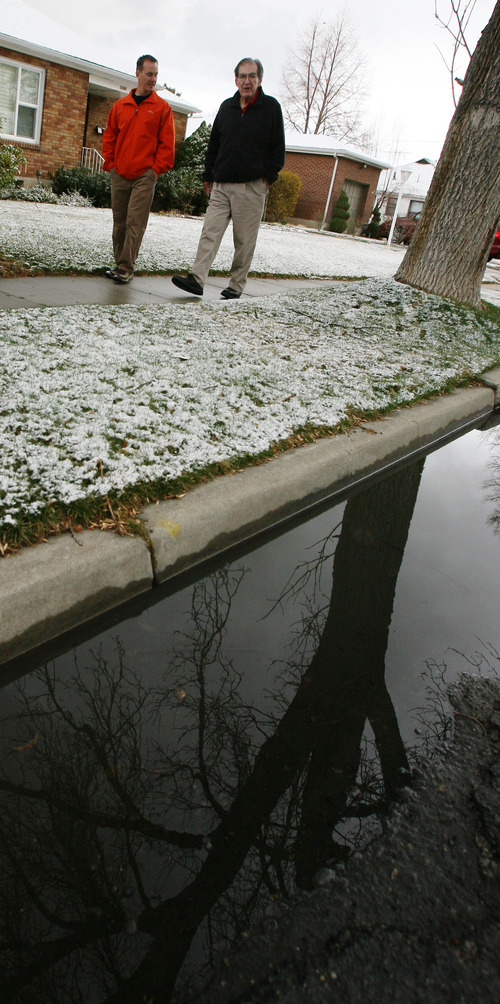This is an archived article that was published on sltrib.com in 2012, and information in the article may be outdated. It is provided only for personal research purposes and may not be reprinted.
Not all body fat is bad, but if it's inside your muscles, it can be very bad indeed.
And kind of weird. Because even when, say, your legs are big, if your muscles are marbled with fat, you can have what is called "poverty of flesh" — the literal translation of the medical term sarcopenia, the loss of muscle mass and strength that plagues many older adults.
That is the essence of research under way by a team of physical-therapy professors and a radiologist at the University of Utah, who through observations and clinical trials at the Health Sciences Center's Skeletal Muscle Exercise Research Facility are searching for the connections between sarcopenia and chronic systemic inflammation — increasingly regarded as the root cause of all degenerative disease.
"Exercise is good," said Paul LaStayo, an associate professor of physical therapy with the College of Health. "Everyone knows that. They're tired of hearing about it."
But decline in muscle function due to an increase in intermuscular adipose tissue — IMAT — may be just as insidious as visceral fat, the abdominal spare tire scientists say increases the risk of diabetes, heart disease and early death.
Aging means loss of muscle, loss of function and possible fat infiltration, said Robin Marcus, an assistant professor of physical therapy. Marcus, LaStayo and four other U. scientists co-wrote a 2012 article examining how and why aging, IMAT and sarcopenia may affect muscle mobility and strength.
"Is it aging or inactivity?" Marcus said. "We think it's preventable. Is it reversible?"
The authors say the study was the first to focus on older people who need rehabilitation related to mobility. It focused on large muscle mass in the thighs, with the knowledge that the amount of fat in muscle can range from normal to detrimental.
Two 69-year-old women in the study underwent MRIs of their muscle about midpoint along their thighs. Though both women were about the same size, had the same amount of muscle and the same body-mass index, one of them had twice the amount of fat inside her muscle. The other, whose MRI shows a ring of subcutaneous fat — not necessarily harmful — surrounding the muscle under the skin, proved twice as strong as her counterpart in six separate measures of leg strength.
So researchers can see that intermuscular fat can affect strength, Marcus said. The cause likely is part mechanical, as the fat literally gets in the way of blood vessel and nerve functions. But there could be some inflammatory factor connecting IMAT and sarcopenia. Marcus said the team needs to do more clinical research.
Sarcopenia and osteoporosis — which arises from osteopenia, a lesser form of bone wasting — are related and often paired because muscles create the mechanical stress needed to maintain bone mass. Inactivity leads to loss of both and can put older adults on a downward health spiral that can be made worse by surgery, traumatic accidents or even illnesses as common as flu.
"With aging, unfortunately, there is a wasting," LaStayo said. "That is accelerated by acute situations where you're knocked down for a week or two" by flu, pneumonia or depression. Surgery and fractures that keep you down longer, he said, cause even more wasting.
The research facility offers 12-week physical-therapy programs that incorporate strength exercise and an obstacle course to build participants' muscle power, balance and endurance. The clinics also offer falls-avoidance education.
"Most of our life is not in 'hit' mode. It's 'waiting to be hit,' " LaStayo said. "We believe in building [strength] reserve in a wellness manner."
Developing that strength requires resistance training and exercise — not just the physical activity of walking, Marcus said. Walking can maintain one's fitness level, but it's not enough to recover from a hit or actually build strength.
Pharmaceutical companies are working on a drug therapy much as they did for osteoporosis.
"I'm realistic enough to know people don't want to exercise," she said.
Salt Lake City resident John Whipple, 91, completed his clinic at the end of October. He said he became more agile through exercises that involved stepping over and around small objects and progressively became more challenging.
As a result, he said, "I'm much more active. The program emphasizes strength training of your legs. It also makes you aware of the possibility of falling."
Fletcher Gross, a 72-year-old retired U. math professor, took the course because "I just had lousy balance," he said. "I sort of tended to move too quickly and there was some weakness there."
A golfer who regularly walked the 18 holes at the hilly Bonneville Golf Course in Salt Lake City three or four times a week, Gross figured he was keeping reasonably fit. He also had been going to Weight Watchers and got within 12 pounds of his goal. In January, though, he took one of the hits LaStayo talked about: total knee replacement surgery followed by an infection and subsequent surgical repair.
These days, a physical therapist comes to his home three times a week. Gross was able to move from a walker to a walking stick to walking unaided with almost full knee mobility and is again working on weight loss. —
Aging and muscle strength
The University of Utah Skeletal Muscle Exercise Research Facility (SMERF) offers physical-therapy clinics for older people with a history of falls or at risk of falls or diabetes. Participants also may be chronically ill, recovering from physical trauma or suffering from Parkinson's disease, a disorder of the brain that leads to tremors and difficulty with walking, movement and coordination.
The 12-week programs incorporate strength exercise and an obstacle course to build participants' muscle power, strength, balance and endurance. Researchers there are seeking people to be part of clinical trials. Contact Odessa Addison (801-585-5961) if you are interested in current research projects. —
Fighting sarcopenia
University of Utah researchers urge seniors to develop healthy, lean muscle mass with resistance training and exercise. Here's why:
With age, motor neurons degrade and muscle fibers atrophy and die. When a motor neuron dies, an adjacent one may fight the atrophy; the replacement is usually connected to a slow-twitch muscle fiber, necessary for endurance.
That can reduce the number of fast-twitch fibers, which fire more quickly and help us recover if we begin to fall. Less balance and speed can lead to inactivity and then sarcopenia, the loss of muscle mass and strength.





